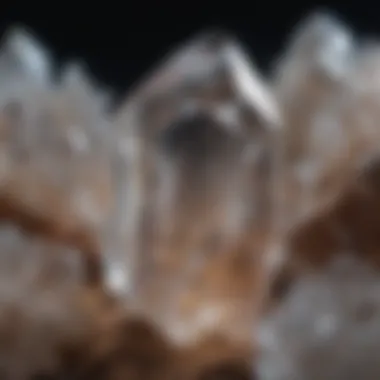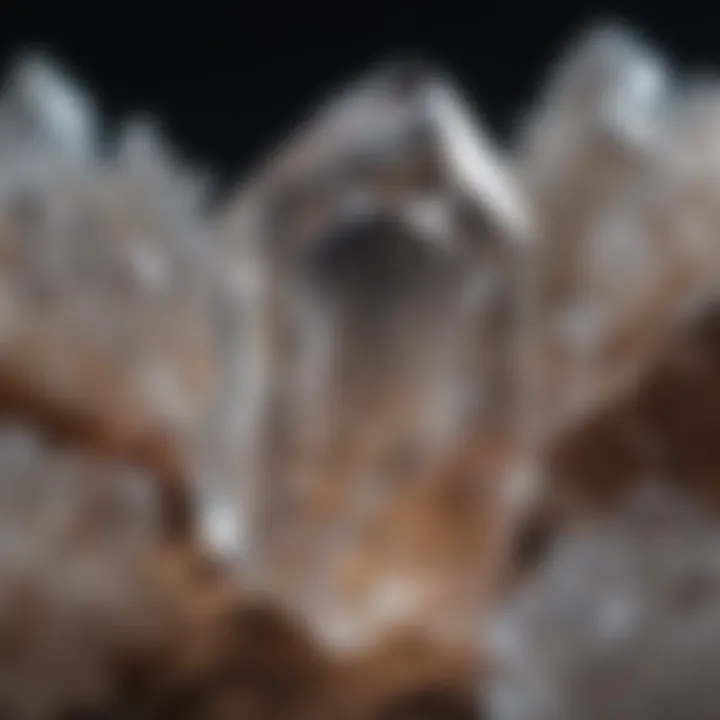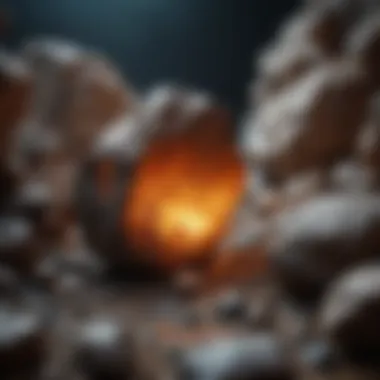Exploring Rocks and Minerals: Visual Insights for Identification


Intro
Understanding rocks and minerals forms the foundation of geology. With countless species on Earth, these natural materials reveal the history of our planet, offering insights into its formation and evolution. Visual representation is an integral tool in recognizing and studying these geological treasures. Pictures often outweigh descriptions in terms of conveying details, becoming essential in both education and appreciation.
Rocks and minerals have diverse classifications, primarily based on their formation and composition. Using visuals, enthusiasts can identify them more effectively, enhancing their connection to the subject. This guide aims to elevate knowledge for both beginners and seasoned collectors through detailed descriptions and clarifying visual elements.
Featured Collectible of the Month
Overview
Each month in the geological community, there is a highlight on a particular specimen. This collectible provides both aesthetic and educational value. The featured collectible, Lapis Lazuli, remains popular for its deep blue hue and unique appearance. It has captivated collectors due to its beauty and storied past.
Historical Significance
Lapis Lazuli is not just a stunning mineral; it also has a rich history. Used by ancient civilizations, notably in Egypt, it was often ground into powder for the creation of pigments. Artists would mix it with oils to paint vivid images on walls and papyrus. This mineral has also been used in jewelry, signifying power and wealth throughout various cultures. Understanding its historical context enhances appreciation for this collectible.
Identification Techniques
Visual Characteristics
Identifying rocks and minerals often relies heavily on visual characteristics. Here are some fundamental elements to observe:
- Color: The mineral’s color can provide immediate clues to its identity.
- Luster: Whether it is metallic, vitreous, or dull can help narrow down possibilities.
- Texture: The feel of the specimen, such as smooth or rough, is important.
- Crystalline Structure: Observing the arrangement of its components can indicate the type of mineral.
Resources for Identification
For those interested in furthering their identification skills, a wealth of resources is available. Some recommendations include:
- Books: Titles such as The Rock and Gem Book provide nuanced explanations and excellent visuals.
- Websites: Websites like Wikipedia and Britannica have detailed entries
- Forums: On platforms like Reddit, community members share insights and tips.
"The beauty of geology lies in the details; the more you observe, the more connected you become to the Earth."
This guide seeks not only to inform but also to inspire engagement with rocks and minerals. By using effective techniques and appreciating their significance, one may develop a profound respect for the geological world.
Prologue to Rocks and Minerals
The study of rocks and minerals is crucial for understanding our planet's composition and the processes that shape it. This introduction sets the stage for a deeper exploration of geological specimens. A structured discussion helps to clarify the distinctions between rocks and minerals, offering insights valuable to both newcomers and experts in this field.
Defining Rocks and Minerals
Rocks and minerals are fundamental components of the Earth's crust, yet they serve different roles in geology.
Rocks are aggregates of one or more minerals and may also include organic materials and mineraloids. Examples include granite, composed primarily of quartz, feldspar, and mica, and basalt, a volcanic rock rich in iron and magnesium. Each rock type captures a unique story of geological history, influenced by formation processes like cooling, sedimentation, or metamorphism.
Minerals, on the other hand, are naturally occurring, inorganic solid substances with a definite chemical composition and crystalline structure. They include a vast array of substances like quartz, calcite, and halite. Understanding the distinction aids in proper identification and classification, enriching our appreciation of geological diversity.
The Importance of Visual Representation
Visual representation plays a significant role in the identification and appreciation of rocks and minerals. Photographs serve as educational tools that provide instant clarity. They allow collectors and geologists alike to visually connect with specimens, facilitating better recognition and understanding.
The use of quality images enhances learning experiences. When one can see the intricate details of a mineral’s crystal structure or the layering of sedimentary rocks, it becomes easier to grasp essential characteristics.
Through photographs, one can also explore the different environments where these materials are found. Visiting various geological sites is not always feasible, but visual documentation offers an accessible alternative to engage with the subject matter.
In summary, rocks and minerals encapsulate our planet’s historical narratives. They are not just materials; they are resources for education, inspiration, and exploration. As we delve deeper into the classifications and identification strategies, a strong foundation in the definitions and importance of visual aids will enrich our journey into the complex world of geology.
Classification of Rocks
The classification of rocks is a crucial aspect of geology, providing a framework for understanding the diverse materials that make up the Earth. By categorizing rocks into different types based on their formation processes, texture, and mineral composition, we gain insight into the Earth's history and the dynamic processes that shape it. This section will explore the three primary categories: igneous, sedimentary, and metamorphic rocks. Understanding these classifications helps collectors identify specimens and appreciate their significance in a broader geological context.
Igneous Rocks
Characteristics
Igneous rocks form from the cooling and solidification of magma or lava. This characteristic is fundamental because it indicates the rock's genesis and the environments in which they may be found. One key feature of igneous rocks is their crystalline texture, which is a direct result of the cooling rate of the magma. Slow cooling, typically underground, creates large crystals, while rapid cooling leads to small or no crystals. This textural variety is significant as it can guide collectors in identifying and classifying the rock type.
Common Examples
Common examples of igneous rocks include granite and basalt. Granite is typically light-colored, coarse-grained, and found in continental crust, making it a popular choice among collectors due to its striking appearance and durability. On the other hand, basalt is dark-colored and fine-grained, forming from lava flows, often seen in oceanic crust. These examples highlight the diversity within the igneous category, allowing enthusiasts to recognize and categorize their finds effectively.


Visual Identification Tips
When identifying igneous rocks visually, the key characteristic to observe is their texture. Collectors should note the size of the crystals, which can vary significantly between individual specimens. A handy tip is to use a magnifying glass to assess the crystal size more clearly. Additionally, color variations can also indicate the mineral composition, serving as another visual clue for collectors.
Sedimentary Rocks
Formation Processes
Sedimentary rocks form through the accumulation of sediments that are compacted and cemented over time. This aspect is vital for understanding Earth's environments and the history recorded within rock layers. The unique feature of sedimentary rocks is their layering, which can indicate the conditions of the environment where sediment was deposited. This layer can also be used for dating purposes, making them essential for geological studies.
Key Features
The key features of sedimentary rocks include stratification and the presence of fossils. Stratification refers to the distinct layers formed during sediment deposition, while fossils provide a snapshot of past life and environmental conditions. Collectors often seek these unique features, as they add historical context and visual intrigue to their samples.
Photographic Examples
Photographic examples of sedimentary rocks, like sandstone and limestone, illustrate their distinct features. Sandstone, with its gritty texture, is often composed of sand-sized particles and can appear in various colors. Limestone often contains fossils and exhibits a softer, more soluble texture. By examining photographs of these examples, collectors can improve their ability to recognize and identify these rocks in the field.
Metamorphic Rocks
Transformation Processes
Metamorphic rocks undergo transformation via heat and pressure, altering their original form. This process is key to understanding how environmental factors can change rock characteristics. The unique feature here is foliation, where layers or bands develop due to the alignment of minerals under stress. Understanding these processes is essential for collectors, as it helps in identifying the origins and conditions surrounding their specimens.
Identifying Traits
The identifying traits of metamorphic rocks often include texture and mineral alignment. For instance, schist has a distinct shine due to the presence of mica, which is aligned due to metamorphic processes. Recognizing these traits allows collectors to accurately classify their finds, deepening their understanding of geology.
Visual References
Visual references, such as photographs of common metamorphic rocks like marble and gneiss, enhance the identification process. Marble, known for its smooth texture, often showcases striking patterns. Gneiss, characterized by its banding, exhibits a complex history of formation. These visual aids are highly beneficial for understanding the complexities of metamorphic rock classification.
Detailed Look at Minerals
Understanding minerals is vital to appreciating the broader field of geology. Minerals play a crucial role in the Earth's structure and formation. This section aims to provide an overview of the key concepts related to minerals, setting the stage for a deeper exploration. By understanding minerals, one not only awakens a keen interest in geology but also enhances the identification of various specimens encountered in collections or nature.
What Constitutes a Mineral?
A mineral is defined as a naturally occurring, inorganic solid with a definite chemical composition and a crystalline structure. This definition encompasses a broad range of natural substances, each with distinct properties that can aid in identification. For example:
- Naturally occurring: Minerals are found in nature and are not man-made.
- Inorganic: They are not derived from living organisms, which is a critical aspect of their classification.
- Solid state: Minerals exist in solid form under normal conditions.
- Definite chemical composition: Each mineral is characterized by its specific chemical formula, which determines its structure and properties.
These elements are fundamental in discussing mineralogy and exploring different minerals present in nature. It enhances appreciation and identification skills.
Major Mineral Groups
Understanding major mineral groups is essential for any collector or enthusiast. This classification helps in identifying and comparing minerals based on their unique characteristics.
Silicates
Silicates are the most abundant group of minerals in the Earth's crust, making up about 90% of it. The key characteristic of silicates lies in their silicon-oxygen tetrahedron structure, a fundamental building block that plays a significant role in defining their properties. This group is beneficial for collectors due to its diverse range of minerals, including quartz, feldspar, and mica. For example:
- Unique Feature: Silicates can form complex structures, leading to a wide variety of physical forms.
- Advantages in this article: Their abundance and variety allow collectors to explore numerous types with different occurrences in various environments.
Carbonates
Carbonates are another important mineral group, primarily composed of carbonate ions ( CO3) in their structure. They contribute significantly to geological processes, particularly in sedimentary rock formation. The key characteristic of carbonates is their ability to effervesce when exposed to dilute acids, a property that aids in field identification. For instance:
- Unique Feature: Their chemical reactivity provides a practical method for differentiating between other groups.
- Advantages in this article: Carbonates can reflect historical geological events and environments, making them interesting specimens for study.
Oxides
Oxides consist of minerals formed from the chemical reaction between oxygen and metals. This group includes minerals such as hematite and magnetite, significant for their industrial applications. The key characteristic of oxides is their variable properties, which can range widely based on the metal involved. Oxides are advantageous in this article due to:
- Unique Feature: Their magnetic properties make some oxides easily distinguishable.
- Advantages in this article: They often play a role in ore mining, and their identification can inform collectors about their potential economic value.
"Understanding these major groups not only aids in collection but fosters deeper appreciation for the role minerals play in our world."
This section has laid a solid foundation for further exploration in the article. With a clear understanding of what constitutes a mineral and a glimpse into the major mineral groups, readers can appreciate the intricacies of rock and mineral identification.
Photographs as a Learning Tool


Photographs serve an essential function in the identification and appreciation of rocks and minerals. They bridge the gap between theoretical understanding and practical application. A strong visual component can enhance learning, allowing collectors to compare their specimens with high-quality images that are readily accessible. Accurate images support better retention of information. They provide context, aiding in the identification process when exploring geological environments.
Visual aids focus attention on features that text alone might not convey effectively. Coloration, texture, and form can often be more easily grasped through a photograph, making the complexities of rocks and minerals more approachable to all audiences. The significance of quality images is paramount; they catalyze learning and facilitate a deeper comprehension of geological specimens.
Importance of Quality Images
High-quality images are vital in showcasing the intricate details of rocks and minerals. Clear photographs capture nuances in color and texture that enhance the identification process. Quality images help illustrate the unique characteristics that differentiate one mineral from another or one rock type from its peers. This clarity reduces misidentifications and supports collectors in making informed decisions.
When pictures are taken well, the light interacts with the surface in a pleasing way, bringing out the best in each specimen. As a result, these images become not just helpful tools but also treasures that resonate with both novice rockhounds and experienced geologists alike.
Techniques for Capturing Rocks and Minerals
Capturing stunning images of rocks and minerals requires proper techniques. Using the right methods can significantly elevate the final outcome.
Lighting Techniques
Lighting plays a crucial role in photography. Natural light, preferably during the golden hours after dawn or before dusk, is an effective choice as it is diffuse and flattering. Soft light reveals the textures and layers of rocks, allowing their details to stand out. Direct light can create harsh shadows, which may obscure important features. Thoughtful lighting ensures each specimen emerges with clarity and distinctiveness, making it a popular choice among photographers.
A common approach is using light tents or diffusers, which minimize harsh reflections and distribute light evenly. However, care must be taken as improper lighting can mask textures or distort colors, leading to misrepresentation.
Background Selection
The background of a photograph is often overlooked but is fundamental. A suitable background can emphasize the rock or mineral, drawing the viewer’s eye directly to the specimen. Neutral colors are a beneficial choice as they prevent distractions. White, gray, or beige backgrounds allow the features of the specimen to stand out without interference.
However, colorful or textured backgrounds can add context and enhance the presentation of certain minerals. Careful consideration is needed, as overly complicated backgrounds may overwhelm the subject. Finding the balance between highlighting the specimen and maintaining simplicity is essential.
Focus and Composition
Good focus and composition are critical for beautiful photographs. Centering the mineral or rock piece draws immediate attention. Using shallow depth of field techniques can highlight details while softly blurring the background, which may aid in isolating the specimen.
Being mindful of composition rules, such as the rule of thirds, can create more dynamic and engaging images. However this doesn't mean strict following of such rules; sometimes breaking them can lead to unique results. A well-composed photograph showcases the beauty of rocks and minerals, allowing viewers to appreciate their intricate details.
"A photograph is a pause button of life, capturing the essence and beauty of geological specimens in a single frame."
In summary, photographing rocks and minerals involves thoughtful consideration of quality images, lighting, background selection, and composition techniques. Each element plays a vital role in ensuring that the final result is not only aesthetically pleasing but also serves as a potent educational resource for enthusiasts.
Resources for Identification
Identifying rocks and minerals can be a challenging task, but having the right resources can make this process much more manageable. This section highlights the importance of utilizing various tools available for identification. These resources not only provide valuable information but also enhance understanding and appreciation of geological specimens.
Field guides, reference books, and online communities enable both novice and experienced collectors to expand their knowledge. They offer critical insights into classification and characteristics of different rock and mineral types. Transitioning from raw observation to a systematic approach in identification is made easy with access to structured information. Ultimately, leveraging these resources leads to a deeper connection with the natural world.
Field Guides and Reference Books
Field guides and reference books are essential tools for anyone interested in rocks and minerals. These publications typically offer a wealth of information, including detailed descriptions of various specimens, color photographs, and identification tips. Most importantly, they often categorize minerals and rocks according to their characteristics, making it simpler to identify specimens in the field.
There are several popular titles in this category, such as "The Audubon Society Field Guide to North American Rocks and Minerals". This guide provides in-depth insights into over 700 species. Field guides help travelers and collectors alike to quickly recognize what they encounter during excursions. Having a physical book can be advantageous; it allows for quick access to information even in remote areas without internet service.
Online Databases and Communities
Online resources have transformed how collectors learn and share knowledge. They provide up-to-date information and continuous engagement with like-minded individuals. Utilizing these platforms can enhance learning and foster community connections.
Suggested Websites
Among various online resources, the website "mineralogicalassociation.ca" stands out for its comprehensive database on mineral species. It hosts a variety of resources, including identification tools and articles written by experts. This site's key characteristic is its user-friendly interface, allowing users to search for minerals based on their chemical composition or physical properties. The database is essential for both beginners and seasoned collectors. A unique feature of this website is its detailed articles covering recent mineralogical studies. The one drawback could be the occasional need for deeper scientific knowledge for complete understanding.
Forums and Discussion Groups
Participation in forums and discussion groups provides invaluable insights and fosters community. These platforms, such as those found on "reddit.com/r/minerals", allow collectors to post questions, share experiences, and showcase their collections. The interactive nature of forums encourages member engagement and peer feedback. A key characteristic of these forums is the diversity of knowledge shared. Novice collectors can learn from the experiences of others, which is often more practical than references alone. However, a potential disadvantage includes the varying quality of information, where inexperienced users may share inaccuracies due to misinformation.
Engaging with these resources allows collectors to deepen their understanding of rocks and minerals, ultimately fostering a richer appreciation for the geological world.
Caring for Your Collection
Caring for a collection of rocks and minerals goes beyond mere appreciation; it is fundamental to ensuring their longevity and integrity. Many collectors invest time, effort, and resources into building their collections. Thus, understanding the right methods for storage and preservation is essential. Proper care can help avoid common pitfalls, such as physical damage due to mishandling, environmental degradation, and deterioration over time.
Storage Solutions
Storage solutions play a pivotal role in how well your rocks and minerals are maintained. Depending on the type of specimens, various types of storage options can be considered. For instance:


- Display Cases: These can protect from dust while offering you the ability to showcase favorite pieces. Ensure they are made from UV-resistant materials to prevent fading.
- Boxes: Using acid-free containers helps avoid chemical reactions that may deteriorate mineral specimens. Labeling them keeps organization straightforward for future reference.
- Shelving Units: Sturdy shelves ensure easy accessibility and can be designed to meet the aesthetic needs of your collection. Keep heavier rocks on lower shelves to prevent them from falling.
Proper storage methods reduce risks of scratches, chips, or unwanted contact with harmful substances. By investing in quality storage solutions, you enhance the view of your collection while maintaining its quality.
Preservation Techniques
When it comes to preservation, understanding various techniques is invaluable. Preserving minerals and rocks means protecting their appearance and structural integrity for many years.
Cleaning Methods
Cleaning methods are crucial for maintaining the aesthetic appeal of your rocks and minerals. Regular cleaning helps remove dust and debris without damaging their surface.
- Gentle Washing: Use soft brushes combined with water to gently remove dirt. Avoid harsh chemicals as they could corrode finishes.
Key characteristic: Gentle cleaning preserves both visual and physical integrity. This choice is popular among collectors because it minimizes the risk of damaging delicate features. It improves the overall appearance while making identification easier.
A unique aspect of this method is that it requires no special equipment. Simply using a natural bristle brush can do wonders. However, be cautious: avoid using any abrasive materials that can scratch the surface.
Preventing Damage
Prevention is better than cure. Preventing damage involves understanding potential risks and acting to mitigate them. Common threats include moisture, extreme temperatures, and exposure to light, which can all negatively affect your collection.
- Controlled Environment: Keeping your collection in a stable environment significantly reduces risks. Avoid basements or attics where temperature fluctuates often.
- Humidity Control: Use silica gel packs in proximity to your collection. They help absorb moisture and keep humidity levels low, thus preventing damage from mold or deterioration.
This approach is beneficial due to its long-term effectiveness in maintaining the condition of your rocks and minerals. It can help preserve their luster and structural integrity for many years, allowing collectors to enjoy their pieces for longer.
"Proper care can significantly enhance not only the beauty of your collection but also the story behind each specimen."
Engaging in ongoing education regarding care techniques is just as crucial. Purchasing reference books or attending workshops can expand your knowledge about the best practices in rock and mineral care.
Shared Experiences in Collection
Collecting rocks and minerals is more than a solitary hobby; it becomes a shared experience that enhances understanding and appreciation of geological forms. Engaging with others in this activity fosters a sense of community. By exchanging knowledge and specimens, collectors develop deeper insights about their collections. This communal aspect can enrich personal and collective understanding of geological contexts and variations.
Collecting as a Community Activity
When individuals come together to collect, they share various perspectives and techniques. Group excursions to quarries or natural formations facilitate connections, leading to discussions about geology and showcases of different specimens. These interactions foster a collaborative spirit. Such activities can enhance enthusiasm, encourage novice collectors to join, and create a welcoming environment.
Participating in clubs or organizations related to mineralogy can further extend this community experience. By joining these groups, collectors have the opportunity to participate in events, such as gem shows and exhibitions, where they can actively engage and learn. This social engagement can prove immensely rewarding for both seasoned and new collectors.
Educational Opportunities
Furthermore, fostering educational opportunities is essential in collective experiences through workshops and field trips. These initiatives not only broaden knowledge but also inspire individuals to delve deeper into the subject. Incorporating educational elements helps to cement interest in rocks and minerals while building essential skills in identification.
Workshops and Lectures
Workshops and lectures are structured environments where collectors can enhance their expertise. These sessions often feature experienced professionals who provide insights into techniques and methods for identification and classification. A key characteristic of these educational formats is their interactive nature, encouraging questions and discussions among participants. This helps to create a conducive learning atmosphere.
Moreover, workshops can provide hands-on experience. Participants can practice what they learn, thus solidifying knowledge in a practical context. They often cover a variety of topics including visual identification, preservation techniques, and ethical collecting practices. This unique combination of theoretical and practical knowledge contributes significantly to the overall understanding of geology, making these events popular among enthusiasts.
Field Trips
Field trips are another valuable aspect of educational opportunities. They offer real-world experiences that cannot be replicated indoors. These excursions allow collectors to observe geological formations in their natural environments. A significant characteristic of field trips is their immersive nature, facilitating direct interaction with rocks and minerals.
The unique feature of field trips is the opportunity to collect specimens legally and ethically from various sites. Collectors can apply their learning in real-time, discussing findings with mentors or peers on-site. This can lead to immediate feedback and shared learning experiences. However, careful planning is needed to ensure adherence to local regulations regarding collecting. Overall, both field trips and workshops serve as vital components in fostering a thriving community of rock and mineral enthusiasts.
The value of shared experiences in rock and mineral collecting goes beyond just the specimens; it cultivates relationships, strengthens knowledge, and inspires ongoing passion for geology.
End
The conclusion serves as a vital component of this article, encapsulating the essence of our exploration into rocks and minerals. Throughout the sections, we have emphasized the importance of visual representation in understanding geological specimens. The identification of rocks and minerals is not solely a scientific endeavor; it is a deeply enriching experience that connects individuals with the natural world.
As we recap the key points discussed, readers can appreciate the classification of rocks, from igneous to metamorphic, each presenting unique traits and historical narratives. Each mineral group, including silicates and carbonates, holds significance not only scientifically but also culturally and aesthetically. This comprehensive understanding fosters an appreciation for the diversity in geology and encourages collectors to deepen their engagement with their collections.
Future exploration directions provide an exciting prospect for both novices and seasoned enthusiasts. Engaging in workshops, attending lectures, and participating in field trips can greatly enhance knowledge and skill in identification techniques. Additionally, joining community forums or using online databases can lead to fruitful discussions and exchange of ideas, thereby enriching the collecting experience.
The synthesis of information throughout this article highlights the multifaceted nature of rocks and minerals. The shared experiences in collection underscore the collaborative spirit of geology. By reflecting on these aspects, readers are encouraged not only to collect but to share and educate others. Such interactions will nurture a vibrant community of rock and mineral enthusiasts.
In summary, the journey through the realms of geology offers more than just identification skills; it cultivates a profound respect for Earth’s materials, urging us to continue exploring, learning, and engaging with the natural world around us.
Recap of Key Points
- Visual representation is key in identifying and appreciating geological specimens.
- Classification of rocks includes igneous, sedimentary, and metamorphic, each with distinct properties.
- Major mineral groups such as silicates, carbonates, and oxides play crucial roles in geology.
- Resources like field guides, online databases, and community forums support identification efforts.
Future Exploration Directions
- Consider attending workshops and lectures to gain deeper insights into geological subjects.
- Participate in field trips to engage with real-world specimens in their natural environments.
- Utilize online platforms, such as reddit.com, for networking and sharing experiences with other collectors.
- Seek additional resources, from platforms like en.wikipedia.org and britannica.com, to stay informed on current geoscience trends and findings.



